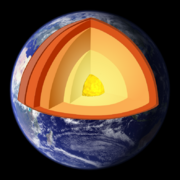Material/print
Intro
Air, water and the twenty most abundant elements in the Earth's crust provide almost all the material needed to create the multitude of machines and goods that mankind requires: food, drugs, houses, vehicles, robots, industrial machinery, computers, consumer goods and so on.
Extracting these plentiful elements (and their compounds) to create useful material essentially involves energy (which is also plentiful) and the right processing methods. From a technical point of view there is practically no limit to the volume of material we could extract and make use of, if we so wished, even while minimally disrupting complex and fragile ecosystems. The reserves of raw materials needed to sustain civilisation are simply not going to run out, because the entire Earth's crust  is made up of them. However this is no excuse to be unnecessarily wasteful in our consumption. Advanced recycling will reduce the need to extract material from the ground and more efficient design will allow us to do more with less
is made up of them. However this is no excuse to be unnecessarily wasteful in our consumption. Advanced recycling will reduce the need to extract material from the ground and more efficient design will allow us to do more with less  .
.
The point is that any existing material scarcity actually has little to do with the reserves at our disposal.
Contents
Twenty most abundant elements in Earth's crust
Approx figures for the 20 most abundant elements in Earth's crust:
| Element | % mass |
|---|---|
| Oxygen | 46.71 |
| Silicon | 27.69 |
| Aluminum | 8.07 |
| Iron | 5.05 |
| Calcium | 3.65 |
| Sodium | 2.75 |
| Potassium | 2.58 |
| Magnesium | 2.08 |
| Titanium | 0.62 |
| Hydrogen | 0.14 |
| Phosphorus | 0.13 |
| Carbon | 0.09 |
| Manganese | 0.09 |
| Sulfur | 0.05 |
| Barium | 0.05 |
| Chlorine | 0.05 |
| Chromium | 0.04 |
| Fluorine | 0.03 |
| Zirconium | 0.03 |
| Nickel | 0.02 |
Notable missing from top 20:
Copper.
Carbon might replace copper for many electrical (and thermal) conduction applications - see [1], [2] and carbon nanotube  for further information. In September 2013, a proof-of-concept computer was built from carbon nanotubes [3]
for further information. In September 2013, a proof-of-concept computer was built from carbon nanotubes [3]
Figures from [4]
Figures rounded to two decimal places
Also need to have a list based on ease of extraction and energy required
Element links in list point to element's Wikipedia article
Constituent elements of seawater
Approximate composition of seawater by mass:
| Element | % mass |
|---|---|
| Oxygen | 85.7 |
| Hydrogen | 10.8 |
| Chlorine | 1.9 |
| Sodium | 1.05 |
| Magnesium | 0.14 |
| Sulfur | 0.09 |
| Calcium | 0.04 |
| Potassium | 0.04 |
| Others | Trace |
Figures from [5]
Need to find definitive primary source
Element links in list point to Wikipedia article
Constituent elements of air
Approximate composition of dry atmosphere by volume:
| Element | % vol |
|---|---|
| Nitrogen | 78.08 |
| Oxygen | 20.95 |
| Argon | 0.93 |
| Carbon | < 0.01 |
| Others | trace |
Not included in above dry atmosphere: | |
Water vapour  (variable) (variable) |
~1% |
Source: NASA
Carbon dioxide updated (to 1998) by IPCC TAR table 6.1 [6]. Figure for carbon extrapolated from this
Edited text from [7]
Element links in list point to Wikipedia article
See also
- Fundamental resources of humanity
- Recycling - making the most of materials we have already extracted from the environment
- Post-scarcity
- Resources in (near-Earth) space




